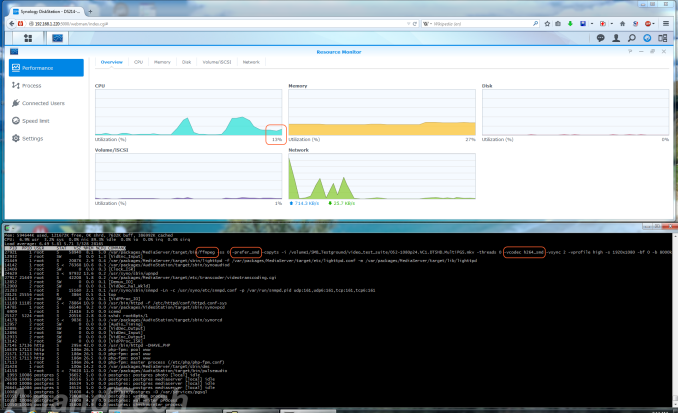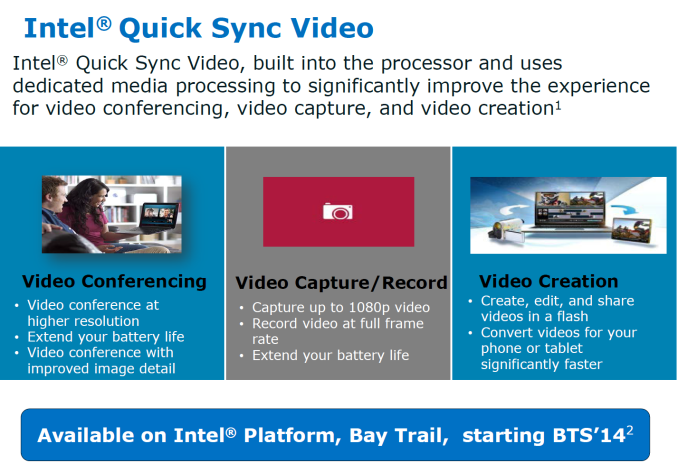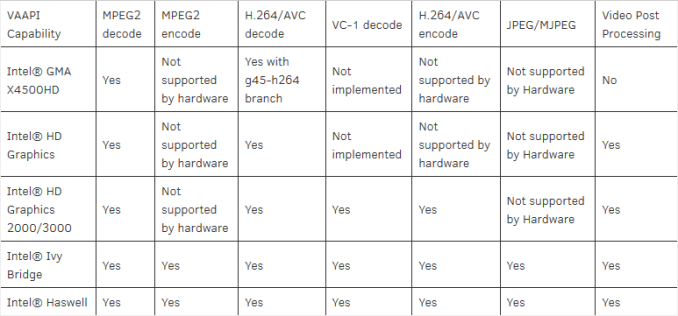QNAP TS-x51 NAS Series: Intel Quick Sync Gets its Killer App
by Ganesh T S on June 22, 2014 6:45 PM ESTHardware Accelerated Transcoding for Media Applications
One of the often-requested features from NAS units that act as media servers is the ability to transcode existing videos to better fit the requirements of the playback device. The popularity of Plex Media Server (which uses ffmpeg for transcoding) amongst consumers is an indication of the market demand for this feature. SoC companies as well as NAS vendors have been trying to address this problem in multiple ways.
Back at CES 2012, I saw Applied Micro's PhiPhi transcoding NAS platform, where the NAS SoC talked to a dedicated Zenverge transcoding chip to achieve the requirements. Unfortunately, I believe the reference design was never taken up by any NAS vendor. In the meanwhile, they continued to take efforts to include the Plex Media Server as a package installable on the NAS.
Evansport Makes the First Move
Intel entered into the picture with their Evansport NAS platform in March 2012. Based on their Berryville STB SoC, it also happened to have a H.264 encoder in addition to a multi-format decoder (giving it the capability to act as a transcoder). We have been pretty bullish on Evansport, having reviewed devices from all of Intel's announced partners (Asustor, Synology and Thecus). While Asustor and Thecus focused on the decoder aspects only, Synology was the only one to utilize the unique hardware transcoding feature.

Synology's Custom ffmpeg Build for Transcoding using Evansport
In order to utilize the transcoder block, Synology had to prepare a custom build of ffmpeg. Given that Intel hasn't announced any follow-ups to either Berryville or Evansport, it is not clear what the future of this series would be. In this situation, it was no surprise that the three partners had nothing new to announce in this lineup at either CES or Computex.
Bay Trail-D and Quick Sync Take Over
QNAP was one of the major NAS vendors who opted out of using Evansport. With the introduction of the TS-x51 series, I can clearly see why they decided to pass it up. One of the major reasons for Evansport's existence in addition to the regular Atom-based NAS units was the fact that a SoC configuration would reduce BOM cost for the vendors. With the Silvermont-based Atoms (which are SoCs), this advantage goes away. While Avoton and Rangeley are great for high-end SOHO / SMB NAS units as well as enterprise cold storage applications, certain consumer-focused aspects are absent. The most important amongst them are the multimedia focused features that Evansport provided. Obviously, cost is also a factor.
In our review of the DS214play, we had talked about how it would be better if Intel actually movied QuickSync over to the Berryville / Evansport follow-up. Instead of waiting for Intel to officially launch a storage platform (like they did for previous generation Atoms), QNAP has just gone forward and built a NAS family with the Bay Trail-D platform. At this point, QNAP's decision to skip Evansport in favour of devoting attention to Bay Trail-D seems to be making a lot of sense.
The Celeron J1800 is one of the first Bay Trail parts to come with Quick Sync, Intel's hardware H.264 encoder. QNAP's QTS OS is a Linux variant, and QNAP has decided to utilize the publicly available VA-APIs to access this Quick Sync engine.
Quick Sync Finds its Ideal Application
When Intel introduced its Quick Sync engine back with Sandy Bridge in 2010, it was pitched as a solution for users needing to transcode videos in a fast manner (particularly for mobile devices which couldn't handle the bit-rate or file sizes of the original stream). Support was restricted to paid software (such as CyberLink MediaEspresso) for a long time. It was only last year that HandBrake, the popular open source transcoding application, got Quick Sync support. However, purists and videophiles often were content with spending extra CPU time to get better quality encodes using x264's advanced options (and two-pass feature).
Quick Sync did make other GPU vendors sit up and put in video encoders on their GPUs too. NVIDIA came out with NVENC and AMD put in VCE. While NVIDIA seemed to have found its niche with recording game play in real-time, VCE is yet to gain as much traction. In addition to HandBrake support, integration into open source screen recorders (such as CamStudio) would help drive up adoption of the Quick Sync encoder in the PC space. Currently, even though Quick Sync was originally meant to be used as a transcoder, I wouldn't be surprised if Eric Gur's Quick Sync decoder (which is part of LAV Filters) was found to be used by more consumers. In any case, most of the interesting open source applications utilizing the Quick Sync hardware features have been restricted to Windows.
On Linux, Intel contributes extensively to the VA-API open source library / API specifications for video processing. Despite not being specifically mentioned, the documentation (table reproduced below) suggests that VA-API's H.264 encode capabilities are tied to the presence of the Quick Sync engine in the processor.
Wowza is one of the commercial applications which takes advantage of the Quick Sync engine on Linux. Downloading the driver package makes it clear that VA-API is being utilized. In the TS-x51 series, QNAP takes advantage of Quick Sync in two ways. The user can pre-transcode video files into different resolutions (where the use-case is similar to Handbrake), but the killer method is real-time transcoding for streaming media (using its mobile app or to a DLNA renderer).
Consumers have long been clamouring for Plex to take advantage of the Quick Sync engine, but the developers have been quite hesitant - deciding to focus on being on as many platforms as possible, rather than optimizing for platforms on which Intel Quick Sync is available. The rapid rise in user-generated media and the evolution of the mobile lifestyle has brought to fore the necessity for low power real-time media transcoding. Quick Sync (particularly in low power SoCs such as the Bay Trail-D / -M) perfectly fits the bill and QNAP's efforts to harness this feature deserves recognition.













49 Comments
View All Comments
ganeshts - Monday, June 23, 2014 - link
In a comment on another recent article, one of the readers stressed that deinterlacing is broken in the Linux drivers for the iGPU. I will check on the status with a review sampleDanNeely - Sunday, June 22, 2014 - link
Two questions, the first is a repeat from the initial announcement a week ago. What virtualization platform/virtual drive container format(s) is supported?The second is, why assume the additional USB3 is done by consuming a PCIe lane instead of by sticking a USB3 hub onboard as is common with current generation motherboards.
modulusshift - Sunday, June 22, 2014 - link
It would consume a PCIe lane either way. He's talking about total lanes from the CPU, not just the number a motherboard would expose like on normal desktops.ganeshts - Monday, June 23, 2014 - link
I am not sure I understand the question entirely, Dan.Are you saying that current generation mobos have the ability to make a single USB 3.0 port from the PCH appear as multiple USB 3.0 ports on the board, i.e, is there a 'USB 3.0 port multiplier' that you are talking about?
As modulusshift indicates, most of the NEC / Fresco Logic / ASMedia based USB 3.0 ports that I see in the motherboards all communicate with the PCH using a PCIe lane.
DanNeely - Monday, June 23, 2014 - link
Yes. A lot of the current generation of boards offering 8 or more USB3 ports that have been reviewed on this site recently are being called out for using a cheaper USB3 hub chip (like what would be inside a 2/4 port USB3 hub on your desk) instead of a PCIe-USB3 chip like in the previous generation.4 of 5 mobo reviews on the front and second page call the board out for using at least on hub to add USB3 ports, just search the first page of the review for the word hub (the 5th only had 6 ports and presumably didn't need one):
http://anandtech.com/show/8045/asrock-z97-extreme6...
http://anandtech.com/show/7965/asus-z97-deluxe-nfc...
http://anandtech.com/show/7966/msi-z97-mpower-max-...
http://anandtech.com/show/7964/gigabyte-z97x-ud5h-...
ganeshts - Monday, June 23, 2014 - link
Got it! Let me see what QNAP comes back with, and I will update the article accordingly.DanNeely - Monday, June 23, 2014 - link
Not a problem. This is something fairly new; and unfortunately appears to be occurring at all pricepoints. I'm mostly ok with doing it on budget boards; but for higher end ones I'd much rather have the option of a 2:4 or 4:8PCIe lane PLX and PCIe-USB3 controllers powering all the ports, rather than have to worry about where I connect high bandwidth devices in the future to avoid bottle-necking. I'm really hoping skylake's chipset will have enough native usb3 ports to make this generation's designs a one off aberration.ganeshts - Wednesday, June 25, 2014 - link
Dan,Virtualization answers from QNAP: OVA, OVF, QVM, XML, VMX.
Confirmed that an USB 3.0 hub chip is being used
SATA - PCIe bridge list update in the article.
extide - Monday, June 23, 2014 - link
No, if you used a USB 3.0 HUB then it would not use a PCIe lane, and that would leave you with two PCIe x1 lanes, so you could add two controllers (ex for the 8-bay you would need a 4-port and a 2-port).name99 - Sunday, June 22, 2014 - link
I find the premise of the article ("Intel Quick Sync Gets its Killer App") to be quite bizarre.In the Apple world, QuickSync has had its killer app for some time supporting remote desktops and video sent from a Mac to an AppleTV. For remote desktops in particular, while this was previously done with software encoding, the lowered latency of QuickSync makes a noticeable difference to the usability if you're connected via a high bandwidth connection. I expect there are substantially more people using OSX ARD than will ever buy this particular NAS.
There are probably similar use cases happening on Windows, but I don't know much about that side of the fence.
My point is not to criticize the NAS or talk up OSX; it's simply to point out that the article subtitle is more than a little ridiculous, suggesting, as it does, that poor little QuickSync was just out there languishing in the world with everyone ignoring it until this NAS came along and showed the world how to utilize it.